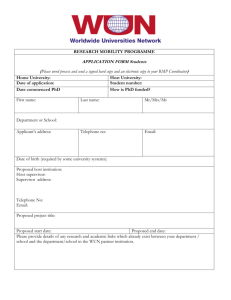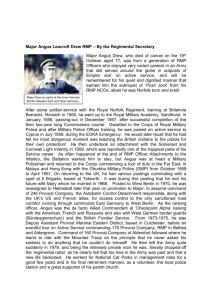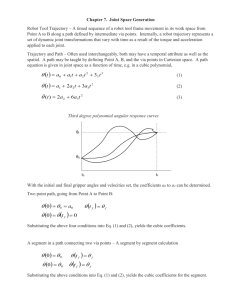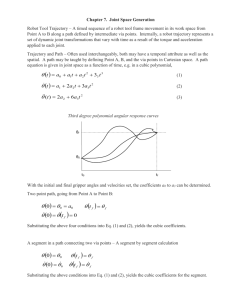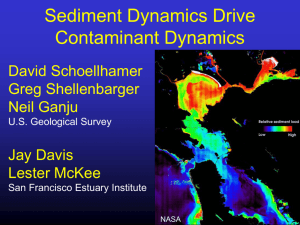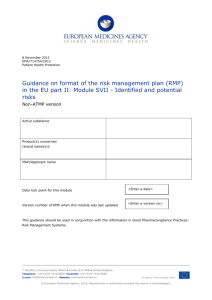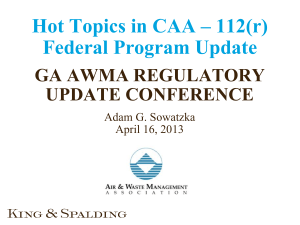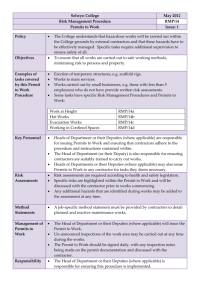Jay-D_RMPMtg-2002 - San Francisco Estuary Institute
advertisement
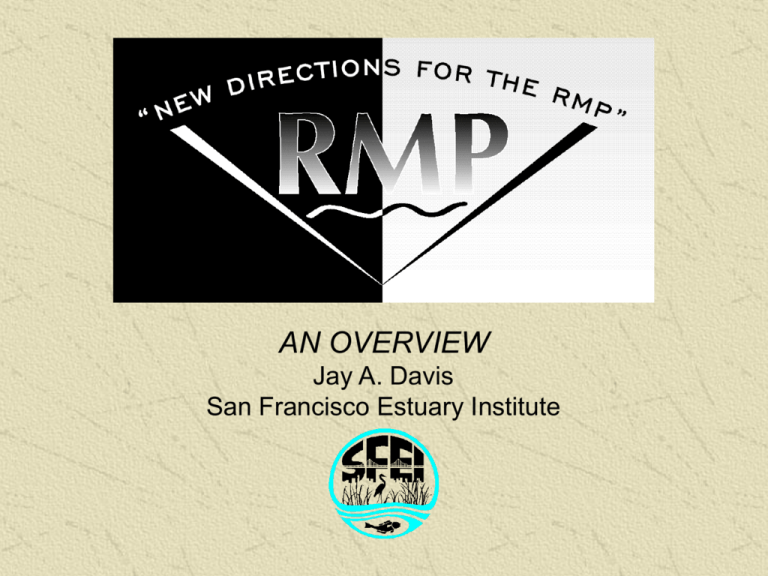
AN OVERVIEW Jay A. Davis San Francisco Estuary Institute Under New Management THE OLD RMP Rainer Hoenicke Bruce Thompson TRC, SC RMP Staff THE NEW RMP Jay Davis Sarah Lowe Bruce Thompson TRC, SC RMP Staff My Priorities for the RMP Technical excellence Peer Review Publication Data interpretation Mass budgets and modeling: prediction Current, well-organized web site Responsive to deadlines and budgets Retain our excellent staff RMP Redesign Process Five Year Review Panel (1997) RMP Workgroups Chlorinated Hydrocarbons (1998) Sources, Pathways, and Loadings (1998) Sediment (1998) Registered Pesticides (1998) Bioaccumulation (1999) Design Integration (2000) Sediment to Biota Transfer (2001) Exposure and Effects (2001) Role of Regional Board: Karen Taberski Reconvene Review Panel in 2003 RMP Objectives (1998) Describe patterns and trends in contaminant concentration and distribution Compare monitoring information to relevant water quality objectives and other guidelines Describe general sources and loading of contamination to the Estuary Measure contaminant effects on selected parts of the Estuary ecosystem Synthesize and distribute information from a range of sources to present a more complete picture of the sources, distribution, fates, and effects of contaminants in the Estuary ecosystem RMP Components 1) 2) 3) 4) 5) Program Management Information Management Status and Trends Pilot Studies Special Studies 1 2 3 4 5 2) Information Management Data Management (Cristina Grosso) Web Site (Patricia Chambers) Information Dissemination (Patricia Chambers) Annual Reporting Pulse of the Estuary (Mike May) Annual Data Summary (Cristina Grosso) Quality Assurance (Don Yee) Data Integration (Ben Greenfield) Data Integration THE OLD RMP Done through special studies THE NEW RMP Explicit part of core program 2002 Tasks: Develop multi-box PCB model (with USGS) Publication of PCB and PAH work Mass budgets for OC pesticides Mercury accumulation model Integration of NOAA and EMAP data 3) Status and Trends Field Work (AMS, SFEI) Water Chemistry (UCSC, Brooks-Rand, Axys) Aquatic Toxicity (PERL) Fixed station, Episodic Sediment Chemistry (UCSC, Brooks-Rand, BACWA) Sediment Toxicity (GCML) Factors Controlling Suspended Sediment (USGS) Hydrography and Phytoplankton (USGS) Bivalve Chemistry (DFG) Fish Chemistry (MLML, DFG): Ben Greenfield Water and Sediment Sampling THE OLD RMP The “Base” Program Fixed stations Focus on channels Seasonal sampling THE NEW RMP The “Status and Trends” Program Redesign work led by Sarah Lowe and Don Stevens Randomly selected locations Equal emphasis on shallows and channels More spatial coverage, no seasonal sampling Analytes THE OLD RMP Old, abbreviated list of priority pollutants THE NEW RMP Surveillance monitoring: Identification of “new” analytes Special study led by Daniel Oros and Bob Risebrough Inclusion of selected analytes in all RMP monitoring Water monitoring of all priority pollutants: Don Yee 4) Pilot Studies Atmospheric Deposition (Mercury Deposition Network) Estuary Interface Pilot Study: Jon Leatherbarrow Exposure and Effects Pilot Study (EEPS!) Contaminant Effects THE OLD RMP Toxicity testing THE NEW RMP EEPS, led by Jay Davis and Sarah Lowe Avian egg chemical trend monitoring (SFEI) Diving duck and clam chemistry (DFG) Avian effects (USFWS): Steve Schwarzbach Seal exposure and effects (SFSU, PRNS, MLML) Toxicity testing and test refinement (GCML, PERL) Benthic community effects (NOAA/USEPA) Fish effects (NOAA) 5) Special Studies Evaluation of Contaminants of Concern Mass Budget Models SPL Literature Review and Planning SPL Field Studies Sources, Pathways, and Loading THE OLD RMP No targeted SPL work THE NEW RMP SPL Workgroup: Lester McKee Literature reviews and workplan development Field studies Loading of Particle-Associated Contaminants from Rivers Contaminant Transfer from Sediment to Biota Loading of Particle-Associated Contaminants from Small Tributaries Prioritization of Small Tributaries Contaminant Profile: Copper/Nickel “Synthesize and distribute information from a range of sources…” Regional Board perspective: Richard Looker South Bay TMDL: Tom Grieb North of Dumbarton TMDL: Tom Grovhoug In Closing The RMP is a world-class monitoring program We want to continue to improve Present challenge in managing the Program is in finding the best way to meet the new objectives within the existing budget 1 2 3 4 5
